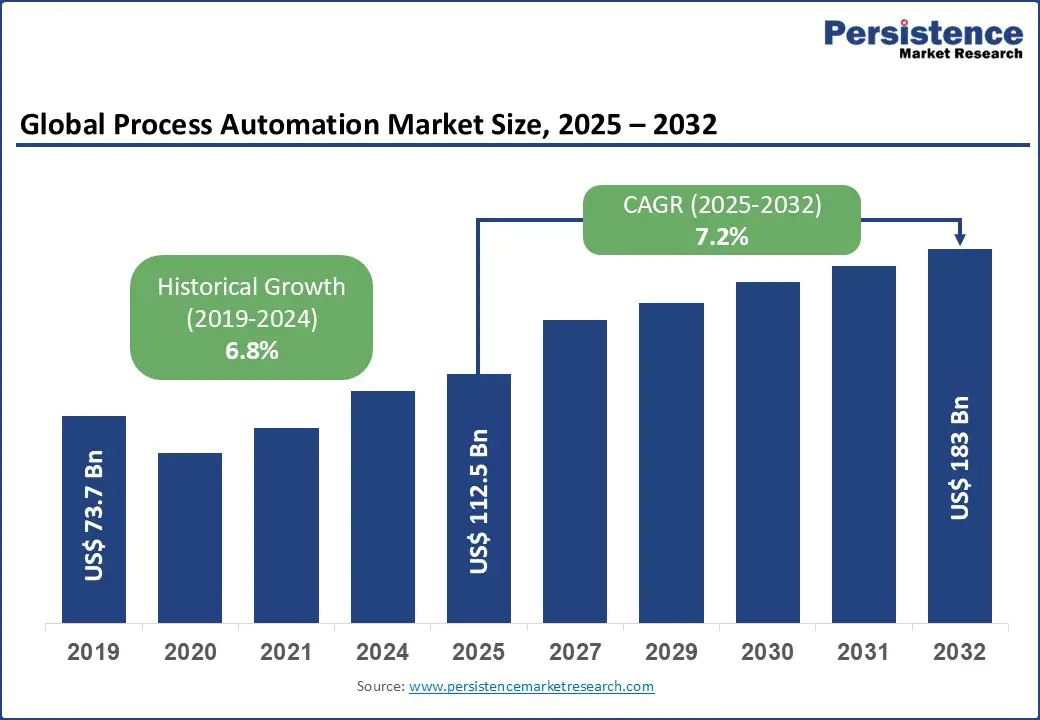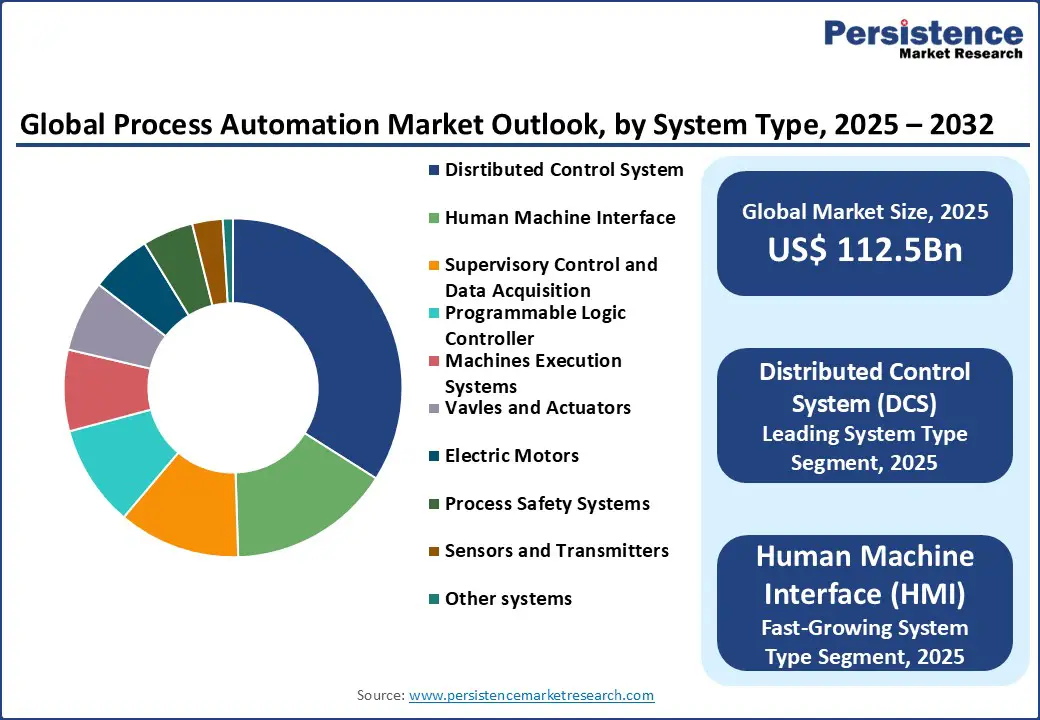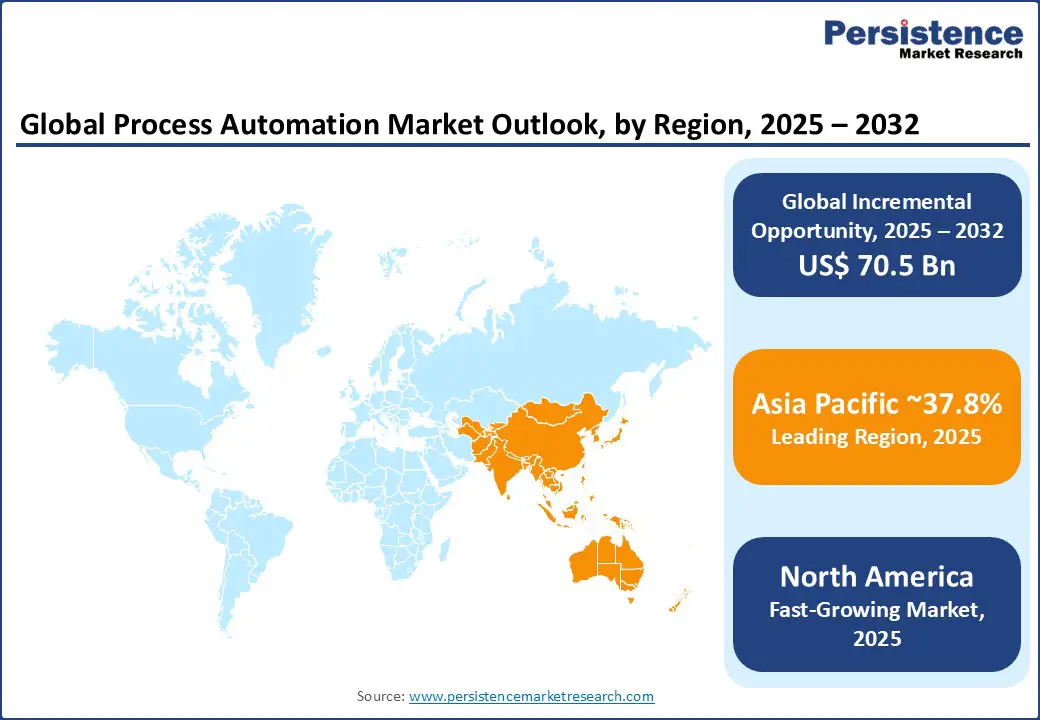ID: PMRREP12688| 178 Pages | 23 Sep 2025 | Format: PDF, Excel, PPT* | IT and Telecommunication

The global process automation market size is likely to value at US$ 112.5 Bn in 2025 and reach US$ 183 Bn by 2032, growing at a CAGR of 7.2% during the forecast period from 2025 to 2032, driven by the increasing need for operational efficiency, cost reduction, and enhanced safety across industries such as oil and gas, pharmaceuticals, and food and beverages.
Process automation systems, including SCADA, PLC, and DCS, enable real-time monitoring, control, and optimization of industrial processes.
Key Industry Highlights:

| Key Insights | Details |
|---|---|
| Automation Market Size (2025E) | US$ 112.5Bn |
| Market Value Forecast (2032F) | US$ 183Bn |
| Projected Growth (CAGR 2025 to 2032) | 7.2% |
| Historical Market Growth (CAGR 2019 to 2024) | 6.8% |
The global process automation market is witnessing significant growth due to the rising demand for operational efficiency and the adoption of Industry 4.0 technologies. Process automation systems, such as SCADA, PLC, and DCS, enable industries to optimize production, reduce downtime, and enhance resource utilization.
According to the World Economic Forum, Industry 4.0 is expected to generate $3.7 trillion in value by 2025, with automation serving as a key enabler. In the Asia Pacific, China’s “Made in China 2025” initiative promotes the development of smart factories, driving demand for automation solutions. In the U.S., the oil and gas sector relies on automation for real-time monitoring and safety.
Companies such as Siemens and Emerson Electric reported an increase in sales of automation systems in 2024, driven by digital transformation. Government incentives for smart manufacturing and the integration of AI and IoT ensure sustained market growth through 2032.
The process automation market faces notable challenges that hinder its rapid adoption and growth. High initial investment costs present a significant barrier, as implementing systems such as Distributed Control Systems (DCS) or Supervisory Control and Data Acquisition (SCADA) requires substantial capital for advanced hardware, specialized software, and skilled labor. Moreover, integrating these automation solutions with existing legacy infrastructure often leads to compatibility issues, which prolong deployment timelines and escalate expenses.
The absence of standardized communication protocols in certain regions, especially cost-sensitive markets such as South Asia, further complicates seamless integration and adoption. Cybersecurity is another critical concern, prompting companies to prioritize secure integration practices. This cautious approach, while essential, restrains the overall market growth, as organizations balance the benefits of automation against the risks and costs involved.
The rising emphasis on renewable energy and pharmaceuticals is unlocking substantial growth opportunities in the process automation market. In renewable energy projects, such as solar and wind farms, automation systems —especially SCADA and Distributed Control Systems (DCS) —play a vital role in precise control, real-time monitoring, and optimizing operational efficiency. The International Energy Agency forecasts global renewable energy capacity to expand by 2.5 times by 2030, significantly boosting demand for these automation solutions.
In the pharmaceutical industry, automation ensures adherence to strict regulatory standards, such as Good Manufacturing Practices (GMP), while enhancing production accuracy and efficiency. Leading companies, such as Rockwell Automation, are innovating advanced Human-Machine Interface (HMI) systems specifically designed for pharmaceutical manufacturing.
These advancements, combined with the integration of AI-driven and energy-efficient technologies, position manufacturers to address evolving industry requirements, driving innovation and growth in the process automation market through 2032.

Asia Pacific dominates, accounting for a 37.8% share in 2025, driven by rapid industrialization, government support for smart manufacturing, and high adoption in China and India. China, the world’s largest manufacturing hub, contributes significantly, with the “Made in China 2025” initiative promoting automation in 70% of factories by 2025.
As of February 2025, China has established over 30,000 smart factories, including 1,200 advanced-level and 230 excellence-level smart factories, which cover more than 80% of the manufacturing sectors. These factories have implemented nearly 2,000 advanced scenarios, such as smart warehousing, AI-powered quality inspections, and digital research and development, demonstrating significant strides in automation and intelligent upgrading.
India’s “Digital India” program boosts automation in pharmaceuticals and food processing. The region’s oil, gas, and chemical industries, supported by companies such as Mitsubishi Electric and Siemens, drive demand for DCS and SCADA systems. Rising investments in smart cities and renewable energy projects are expected to ensure the Asia Pacific’s market leadership through 2032.
North America is the fastest-growing region in the process automation market, driven by its advanced industrial infrastructure and substantial investments, particularly in the oil and gas and pharmaceutical sectors in the U.S. and Canada. The U.S. oil and gas industry heavily relies on automation technologies to enhance safety, operational efficiency, and regulatory compliance amid complex and often hazardous environments.
Automation systems such as Distributed Control Systems (DCS) and Supervisory Control and Data Acquisition (SCADA) are critical in optimizing production and minimizing risks. Meanwhile, Canada’s pharmaceutical sector fuels demand for Manufacturing Execution Systems (MES) and Human-Machine Interface (HMI) systems to maintain stringent quality standards and improve process reliability, as reported by Canadian Manufacturers & Exporters.
Market leaders such as Rockwell Automation and Emerson Electric leverage their extensive service networks and expertise to support smart manufacturing initiatives and renewable energy projects across the region. Their innovations and robust presence solidify North America’s dominant position in the global process automation landscape.
Europe is the second-fastest-growing region in the process automation market, driven by stringent safety regulations, rising demand in the pharmaceutical and energy sectors, and substantial infrastructure development, particularly in Germany and France. The European pharmaceutical industry increasingly relies on automation to ensure regulatory compliance, improve production efficiency, and maintain high-quality standards amid complex manufacturing processes.
Germany’s Industry 4.0 initiatives further accelerate growth by promoting smart manufacturing technologies, which drive demand for advanced Human-Machine Interface (HMI) systems and wireless communication protocols that enable seamless connectivity and real-time monitoring.
Additionally, the EU’s Horizon 2030 program supports renewable energy development, fueling the adoption of Supervisory Control and Data Acquisition (SCADA) systems, which are essential for managing distributed energy assets.
Leading companies such as Siemens and Schneider Electric play a critical role by innovating automation solutions tailored to meet strict regulatory requirements and sustainability goals, positioning Europe as a dynamic and evolving hub for process automation market growth.

The global process automation market is highly competitive and fragmented, with numerous global and regional players. Leading companies, such as ABB Ltd, Siemens, and Emerson Electric, dominate through extensive product portfolios and global distribution networks.
Regional players focus on localized offerings, particularly in the Asia Pacific. Companies are investing in AI-driven automation, IoT integration, and energy-efficient solutions to enhance market share, driven by demand in oil and gas, pharmaceuticals, and renewable energy sectors.
The Process Automation market is projected to reach US$112.5 Bn in 2025.
Rising demand for operational efficiency and Industry 4.0 adoption are the key market drivers.
The Process Automation market is poised to witness a CAGR of 7.2% from 2025 to 2032.
The growing adoption of renewable energy and the pharmaceutical sectors is the key market opportunity.
ABB Ltd, Siemens, Emerson Electric, and Rockwell Automation are key market players.
| Report Attribute | Details |
|---|---|
| Historical Data/Actuals | 2019 - 2024 |
| Forecast Period | 2025 - 2032 |
| Market Analysis | Value: US$ Bn/Mn, Volume: As Applicable |
| Geographical Coverage |
|
| Segmental Coverage |
|
| Competitive Analysis |
|
| Report Highlights |
|
By System Type
By Communication Protocol
By End-use
By Region
Delivery Timelines
For more information on this report and its delivery timelines please get in touch with our sales team.
About Author